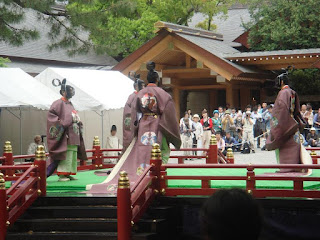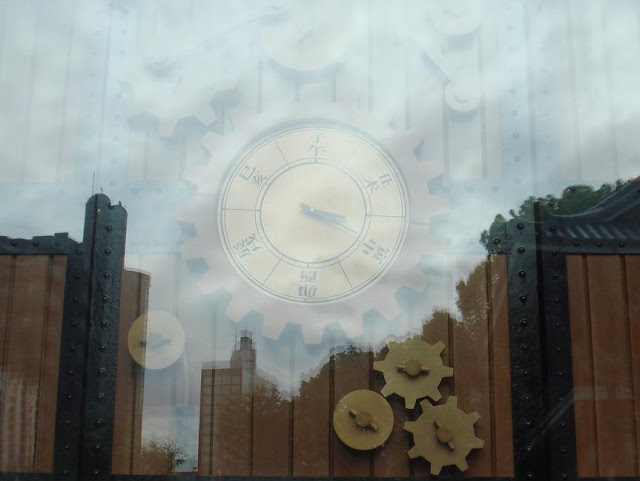On the third day (April 30), my friend had to work so I took “Sakura-dori Line” to Nagoya Station by myself. The hotel I stayed was in Marunouchi 丸の内, 2 stations away from Nagoya Station. I started my lonely trip around noon, it’s a bit scary since I could not speak Japanese and not many Japanese could speak English neither. I was standing at the platform in Marunouchi Station for a few minutes since I forgot which direction to take L A train came, probably the right one … Just jump on! In worst case scenario, I could take opposite direction if it was not Nagoya Station after 2 stops. 死就死la, 最多坐返對頭車如果搭錯咗!
Luckily it was the right train J I browsed Takashiyama department store, Meitetsu department store, an underground mall, and the souvenir stores in Nagoya Station. Even though it was Monday, the department stores were busy due to the Golden Week. Domestic economy was strong in Nagoya, I saw many local customers and local tourists carrying bags of goods. I hardly ran into any foreigners except four Caucasians and three Cantonese women.
I was like a silent lady there 啞女, sometimes staff talked to me or gave me sample to eat when I was paying attention to a particular product. I could only reply by smile.
In Japan, 端午節 is very different from China … not on May 5 of lunar calendar, not eating sticky rice wrapped in bamboo leaves 粽 and no dragon boats. It is on May 5 of western calendar and they eat rice cakes wrapped in oak leaves 柏餅.
I was looking for some souvenirs and saw quite a few people buying boxes of 赤福. One customer was carrying at least 7 boxes of 赤福. What is 赤福? It is a rice cake covered with sweet red bean paste called “Akafuka mochi”, a famous souvenir from Ise in Mie Prefecture (伊勢名物). Price was reasonable too, 6 pieces for ¥ 630 or 8 pieces for ¥ 700 (around 8 to 9 bucks in CAD). Even though it was super popular, I would like to try first before my final decision. I bought a small plate with 3 pieces for ¥ 280 … Uh Oh! I wasn’t sure it was tax inclusive or exclusive. To avoid communication problems, I gave ¥ 500 for change. ¥ 280 was tax inclusive and the saleslady said something I didn’t understand … maybe “Thank you, thank you. Enjoy, enjoy”? Again, I replied by smile.
When I met my friend after his work, I showed him Akufuka mochi and told him that I planned to buy it as souvenirs. His reply unfortunately was the mochi could only be kept for three days.
In the evening, we had dinner at Vertex Garden in Kanayama again. The ambiance was quite nice with delicate food in small portions. It was pricy though, around CAD 50.00 per person. The dishes included sashimi, shrimp, asparagus, Japanese steak, tofu, eggplant, sea urchin, special rice and soup, dessert top with raspberry sauce, etc.
Next day was a spiritual day for me with the visit to both a shrine and a temple. Japan’s two traditional religions are Shinto 神道 and Buddhism 佛教. Shinto is the indigenous religion of Japan with the belief that spirits (kami 神) are found in all living things such as waterfalls or ancient forests. It can be traced back to 200 BC. Buddhism was introduced into Japan via Korea and China in the 6th century.
Shinto shrines 神社 or 神宮 are the places of worship and the homes of kami. The shrine I visited is called Atsuta Shrine 熱田神宮, established 1900 years ago in Nagoya. The shrine houses a sword called the Kusanagi-no-tsurugi 草薙劍, one of the three sacred treasures of the Imperial House appearing in Japanese mythology. The chief deity in Atsuta Shrine is Atsuta-no-Okami, as represented by the sacred sword, Kusanagi-no-tsurugi. Also enshrined are the five great gods of Atsuta, all of whom are mythologically connected with the sacred sword: Amaterasu-Ōmikami, Susano-no-Mikoto, Yamatotakeru-no-Mikoto, Miyasuhime no-Mikoto, and Takeinadane-no-Mikoto.
The area of this shrine was kind of huge with lots of tall trees providing shades and breeze. It was very comfortable and enjoyable to walk there on a hot sunny day. There were a few gates called torri 鳥居 at the entrance of and inside Atsuta Shrine. Every time before I entered or after I existed through the gate, I had to make a bow to the torri.
I got no clue what the event or performance was for. Somehow I felt the musicians and music they played were similar to the imperial music school 掌樂院 in the historical Korean drama “Dong Yi” 同伊.
Here’s the front of the main shrine building where people can pray. I saw prayers throw the coins into the offering box, bow twice, clap hands twice, bow once more and pray. Why clapping hands? Based on my online research, it’s to get the Shinto deity’s attention so the prayer’s wish would be listened.
In Chinese temples, 求籤 (divine by drawing lots) are common. There is a bucket containing bamboo or wooden sticks which we keep shaking until one stick drops to the floor, then we match the number on the stick with corresponding poem printed on a piece of paper. Our lots mainly divided into three categories: 上籤 (good luck) 中籤 (so-so) and 下籤 (bad luck) which is indicated on the piece of paper with the poem in the front and explanation on the back. Depending on what the person wants, it can be applied to own safety, wealth, career and marriage, etc.
I found similar practice called “omikuji” 御神籤 in Atsuta Shrine which was quite interesting! Let’s try! Paid ¥ 200 first, shook the wooden box until one stick came out from a small hole. Gave the number shown on the stick to the counter lady and she handed me a piece of paper … of course I won’t tell you the result … hehe! Instead of 上籤 中籤 下籤, the level of luck indicated on the paper was mainly written as: 吉 (good luck) 末吉 (so-so) and 凶 (bad luck). It seemed to me there was also a poem on the paper and clear information about what would happen to one’s study, travel, health and love, etc.
We always keep the piece of paper with fortune telling. How come they tied the papers to the wires? Oh! It’s a custom to fold the unfavourable omikuji and attach it to a tree’s branch or a wire in the shrine so the bad fortune will not come true.
Ema 絵馬, wooden plates with visitors wishes written by hands, were hanging up in the shrine. I think most people wish for good health, good marriage or passing school exams. The water fountain on the right photo was used for purification where some visitors cleaned their hands before approaching the main shrine, I think.
This giant tree (大楠樹?) is 1300 years old and is said to be planted by Kouou Daishi 弘法大師, a famous Buddhist priest. With the mark by shimenawa 注連繩 (a straw rope with white zigzag paper strips), it is considered a sacred tree 神樹. Some visitors prayed in front of the sacred tree with the belief that kami was in there.
Chicken found in Atsuta Shrine! My friend told me that they were probably Cochin, Nagoya local chicken. The chicken wings I had the night before were most likely from Cochin.
There I found a clock with Chinese system for reckoning time 中國時辰 - 子、丑、寅、卯、辰、巳、午、未、申、酉、戌、亥. It is divided into twelve earthly branches 地支:
So, the clock shown 20 minutes after 未時 which was 3:20 pm.
Next destination was Osu Kannon Temple 大須観音寺, a Buddhist temple near Osu Kannon Station in Nagoya. I’ve been to Buddhist temples or Guanyin temples 觀音寺 in Canada and Hong Kong so it was an interesting experience for me to visit the Buddhist temple in Japan. For those not familiar with Guanyin or Kannon 觀音, she is the bodhisattva 菩薩 highly respected in Asian cultures and is considered goddess of mercy and compassion. It is believed that Guanyin was originated as the Sanskrit Avalokitesvara, which is her male form.
Osu Kannon temple was originally built in Gifu Prefecture in 1333 and was relocated to its present location in 1612 due to the flooding.
There I found a clock with Chinese system for reckoning time 中國時辰 - 子、丑、寅、卯、辰、巳、午、未、申、酉、戌、亥. It is divided into twelve earthly branches 地支:
子 = 23:00 pm – 1:00 am
丑 = 1:00 am – 3:00 am
寅 = 3:00 am – 5:00 am
卯 = 5:00 am – 7:00 am
辰 = 7:00 am – 9:00 am
巳 = 9:00 am – 11:00 am
午 = 11:00 am – 13:00 pm
未 = 13:00 pm – 15:00 pm
申 = 15:00 pm – 17:00 pm
酉 = 17:00 pm – 19:00 pm
戌 = 19:00 pm – 21:00 pm
亥 = 21:00 pm – 23:00 pm
In Chinese Buddhist temples, I normally light the incense, pray in front of Buddha statues, bow three times and stick the incense into the ash container. In Osu Kannon Temple, we are supposed to wave the heat from the large container with some burning fire toward our body, then go into the main hall 仏堂, throw coins into offering box, clap hands twice and pray in front of the Buddha statue. Some visitors rang the bell to get Buddha’s attention before the pray.
Same as Atsuta Shrine, I found ema and omamori 御守 in Osu Kannon Temple. Omamori are Japanese amulets made with the name of the originating temple or shrine on the front and a charm on the back. The common ones I saw were traffic safety, good health, good study and good luck in love.
Unlike Atsuta Shrine, I saw many sculptures and some Buddhist scriptures 佛經 in the temple. From the travel book I read, Osu Kannon Temple houses 15,000 books including the oldest manuscript of the Kojiki which describes the ancient Japanese mythologies.
There were plenty of pigeons in the front yard of Osu Kannon. The temple offered bird food for ¥ 50 and a mom asked her small boy to feed a bunch of pigeons.
Adjacent to Osu Kannon Temple is its shopping area where more than 90 restaurants or cafes and more than 80 boutiques or clothing stores can be found. There are also souvenir and gift shops, supermarket, drug store, beauty salon, and computer stores, etc. Basically I couldn’t finish shopping there since it was too huge and the streets were too long.
Here’s a Hong Kong restaurant I found in Osu shopping arcade.
Osu is a place with variety of restaurants such as Taiwan bubble teas and Italian spaghetti. An interesting one I passed by was a Turkish restaurant called Mega Kebab!
My friend and I decided to leave Osu since it took forever to shop. We were heading to the closest train station “Kamimaezu” … on the way I saw another Hong Kong restaurant at a corner!
We took train to Sakae 榮, another busy downtown district other than Nagoya Station, for dinner. Maneki-neki (lucky cats/招財貓) at the entrance of a shopping mall in Sakae, let me have a picture with them! I saw lots of maneki-neki at the luggage pickup in Chubu Centrair International Airport but didn’t have chance to take photos.






































No comments:
Post a Comment